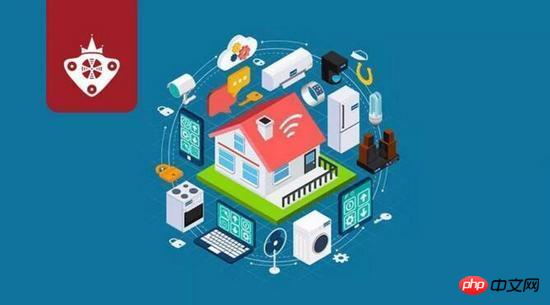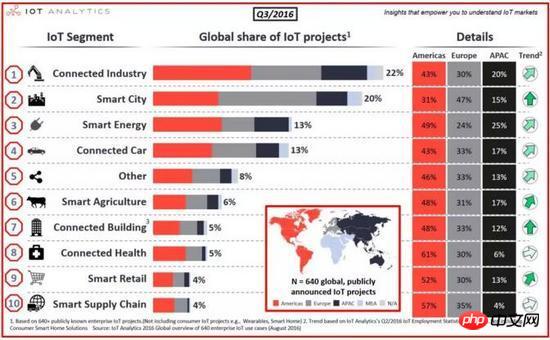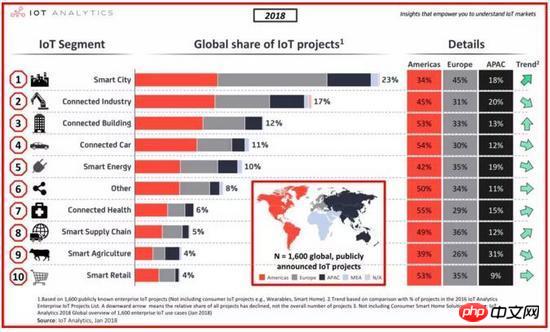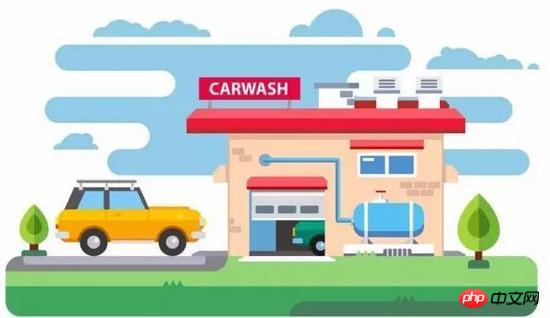These IoT applications that may be popular in 2018

Every year at this time, IoT Analytics, a well-known IoT research organization, will explore the specific implementation of IoT projects based on the numerous information in the market, and this year is no exception. As an important part of its tracking of the IoT ecosystem, IoT Analytics has integrated, verified and classified 1,600 IoT projects actually running in enterprises, structured them and summarized them into an easy-to-use database middle.
Based on the update of the database, IoT Analytics released the "2018 Top Internet of Things Project Ranking", which contains a large number of in-depth insights hidden behind the data. Only through this article, some of the insights are shared.
For comparison, we can first review the ranking of IoT applications in 2016:

Figure: Top IoT application rankings in 2016
The picture below is the updated "2018 Top Internet of Things Project Ranking":

Picture: 2018 Top Internet of Things Application Ranking
us Most of the IoT projects explored were in the smart cities (367) sector, followed by connected industry (265) and connected buildings (193). Geographically, the majority (45%) of IoT projects are concentrated in the United States, followed by Europe (35%) and Asia (16%). When looking at a specific type of IoT application, the geographical distribution is quite different: most smart city projects are located in Europe (45%); while in the Americas, especially North America, there are significant differences in smart healthcare (55%) and Internet of Vehicles. (54%) are very strong in the field; Asia/Pacific region performs more prominently in the field of smart agriculture (31%).
Compared to the 2016 rankings, smart city IoT applications (driven by government and municipal agencies) surpassed industrial IoT to become the most diverse area of all IoT projects we studied; and connected buildings (driven by building automation solutions that can help owners improve operational efficiency and reduce costs) climbed four levels in a row and became the third largest category of IoT applications.
1. Smart City
The needs of traffic flow management and public utilities drive the development of IoT applications in smart cities

Smart City It is currently the largest category (23%) among the IoT projects we studied, surpassing the hottest industrial IoT in 2016. Recently, governments and municipalities around the world have launched hundreds of smart city innovations, with Singapore and Barcelona being prime examples.
Currently, the most popular smart city applications are smart transportation applications including smart parking systems, smart traffic monitoring, shared bicycles, smart bus dedicated roads and other projects. Of course, there are also some more distinctive applications, such as smart ferry systems or smart bus waiting rooms...
Other smart city innovations revolve around the utility fields focusing on lighting, environmental monitoring and public safety. . From a geographical perspective, Europe has the largest number of smart city projects (164).
2. Connected Industry
There are many excellent IoT projects in “non-factory” environments
Of the IoT projects we surveyed, 17% were related to industry Related. This field covers a wide range of connections, both "in-factory" and "outside the factory".
The most popular industrial IoT application is the monitoring of equipment in non-factory environments. Typical "non-factory" projects include monitoring cranes, forklifts, drilling wells, and even entire mines and oil fields (such as Cisco's Connected machines such as Western Australia and Rio Tinto Mining Group’s connected mining operation are remotely monitored.
"Smart factory" automation and control is the second most popular Industrial IoT application - including product production monitoring, wearable devices for industrial field personnel, remote control PLCs, and automated quality control systems (e.g. automotive Parts manufacturer Varroc is using Altizon's digital factory solution to connect its industrial equipment to a turnkey solution.
3. Connected Buildings
Since 2016, the number of IoT projects in the connected building category has increased the most
Compared with the research results in 2016, among all IoT projects Among project categories, IoT applications in connected buildings increased the most (by 7 percentage points). 61% of connected building projects involve building automation with the aim of reducing energy costs. Thirty-nine percent of projects were related to building safety, and 31% involved HVAC/refrigeration/heating.
Case
In the future, as the urban population increases and the consumer structure becomes younger, the demand for hotel stay experience will change significantly. As a result, from the beginning of hotel design and planning to implementation, construction, and operation, guest experience, service and management will become the focus, and new challenges will arise.
As a leader in the field of energy efficiency management and automation, Schneider Electric has always been deeply involved in the hotel industry and regards close cooperation with hotel management groups as one of its important development strategies. Relying on the new EcoStruxure architecture and platform, it targets hotels’ power and energy management, equipment management and operation and maintenance, intelligent means and digital applications, as well as guests’ higher needs in terms of safety, quietness, privacy, comfort and operability. , Schneider Electric has provided customized solutions for many hotels.
Since 2008, Hilton Hotel Group has deployed Schneider Electric smart hotel products in all its settings based on Schneider Electric Resource Advisor resource advisory system, and established a cloud software platform that can track energy costs. It coordinates the energy data of its 1,000 hotels through modular applications and regularly receives improvement suggestions from Schneider Electric, thereby unlocking energy-saving potential and using energy procurement support to save 3% of its annual energy expenses. In the first cooperation between the two parties This year, energy consumption was reduced by 14.5%.
In addition, Suzhou Wujiang Renaissance Hotel, Hong Kong Renaissance Harbor View Hotel, Shanghai Baohua Marriott Hotel, and even more hotels of different levels under the Marriott Group in the future will use Schneider Electric's EcoStruxure-based system and Services, including energy efficiency and sustainability consulting, intelligent power distribution systems, building automation, lighting, guest room solutions and UPS, enable energy efficiency cost savings of up to 10%-15%. The improvement of Marriott Group's energy efficiency is due to better system design and higher system integration.
4. Internet of Vehicles
The leading application is vehicle diagnosis and fleet management

Since the release of the Internet of Things project rankings in 2016, The number of vehicle network projects we counted has more than doubled, most of which are concentrated in the fields of vehicle-connected diagnostics (77%) and fleet management (57%) solutions.
For example, TracknStop, a remote monitoring software company located in Ireland, has released its vehicle diagnostic solution, including real-time tracking, sensor reading monitoring, and remote vehicle control.
5. Other Noteworthy Insights
Low Power Wide Area Network (LPWAN) connectivity technology is developing rapidly
Of all projects we surveyed, 7% of IoT The project applies new and upcoming LPWAN technology. 64% of these projects are focused on smart cities, while other projects focus on smart agriculture and smart energy. Among these projects, LoRa technology accounts for 37%, followed by SigFox (21%) and NB-IoT (19%).
In the "Vodafone 2017 Internet of Things Market Barometer", they are also optimistic about the development of LPWAN
The report stated: Choosing the right connection service is crucial. As the number and types of devices used by users increase, and more complex projects need to be deployed, the demand for connection services will naturally increase. There are countless types of IoT projects, and the demand for connectivity services is naturally diverse.
Enterprises need to make the best choice for connectivity services for different purposes, but few businesses rely solely on one connectivity service solution. Nearly a quarter of the companies surveyed said they are considering using narrowband IoT to deploy IoT projects. This is the beginning of a new technology for low-power wide-area networks. Even those enterprises that have completed IoT deployment and are already using IoT are still interested in low-power wide-area networks (LP-WAN) (16% of IoT adopters). However, companies planning to deploy the Internet of Things are more interested in low-power wide-area networks. 28% of companies considering applying the Internet of Things are studying low-power wide-area networks (LP-WAN), which may set off a new wave of IoT applications. tide.
Most enterprise IoT projects focus on cost reduction
The primary value driver for most enterprise IoT projects is cost savings (54%); only 35% of IoT projects The purpose was to increase revenue (e.g., offering new IoT-related products and services); 24% of projects also increased the overall security of the enterprise (e.g., by providing enhanced monitoring systems with real-time alerts and notifications). )
The number of jobs in IoT companies is growing, but most are small-scale deployments
While this list of 1,600 IoT projects is not complete, our analysis can still Helps us conclude that the total number of IoT projects announced and launched globally is still very limited. Combining this list of IoT projects with other sets of data points, we believe the total number of global enterprise IoT projects (including unpublished IoT projects) is between 10,000-30,000.
This data range is consistent with our overall market model and our insights - the IoT market has not entered the explosive stage, but relies on many pilot projects and small-scale applications, and is still growing at a rate of 30-40% is growing steadily – with some verticals experiencing above-average growth, such as smart cities.
This steady growth trend is expected to continue until the end of 2018.
6. Other interesting materials
Finally, just for fun, share some unique IoT projects we found during our research:
In Scotland, a very cool project is using smart telemetry tags and NB-IoT technology to track and monitor the movement of seals. Marine scientists will monitor seal populations by attaching harmless telemetry tags to the fur on their heads. In this case, the ocean tag works in a similar way to a smartphone, relying on IoT technology to collect important information about the seal.

On the other side of North America, tornado monitoring solutions are providing predictive warning services to residents living in hazardous areas to save lives.
With climate change being such a hot topic at the moment, we're big fans of London's 'Smogmobile', a solution that includes greenhouses capable of measuring carbon dioxide, methane, ozone, nitrogen dioxide and fine particulate pollutants. Sensors for gases, these pollutants are clearly harmful to health.
Finally, NASA is using connected Robonauts in space for air quality monitoring. NASA has always wanted to develop dexterous robot astronauts, so they developed the Robonauts series of robots to help or replace humans in working in space. NASA writes on its website: Space robots will perform simple, repetitive or dangerous tasks on the International Space Station. NASA has made great progress in the construction of space robots. In 2011, they successfully sent the robot Robonaut 2 to the International Space Station and controlled it remotely.

Hot AI Tools

Undresser.AI Undress
AI-powered app for creating realistic nude photos

AI Clothes Remover
Online AI tool for removing clothes from photos.

Undress AI Tool
Undress images for free

Clothoff.io
AI clothes remover

Video Face Swap
Swap faces in any video effortlessly with our completely free AI face swap tool!

Hot Article

Hot Tools

Notepad++7.3.1
Easy-to-use and free code editor

SublimeText3 Chinese version
Chinese version, very easy to use

Zend Studio 13.0.1
Powerful PHP integrated development environment

Dreamweaver CS6
Visual web development tools

SublimeText3 Mac version
God-level code editing software (SublimeText3)

Hot Topics
 Is robotic IoT the future of manufacturing?
Mar 01, 2024 pm 06:10 PM
Is robotic IoT the future of manufacturing?
Mar 01, 2024 pm 06:10 PM
Robotic IoT is an emerging development that promises to bring together two valuable technologies: industrial robots and IoT sensors. Will the Internet of Robotic Things become mainstream in manufacturing? What is the Internet of Robotic Things? The Internet of Robotic Things (IoRT) is a form of network that connects robots to the Internet. These robots use IoT sensors to collect data and interpret their surroundings. They are often combined with various technologies such as artificial intelligence and cloud computing to speed up data processing and optimize resource utilization. The development of IoRT enables robots to sense and respond to environmental changes more intelligently, bringing more efficient solutions to various industries. By integrating with IoT technology, IoRT can not only realize autonomous operation and self-learning, but also
 What are the roles of artificial intelligence and machine learning in the Internet of Things?
Jan 30, 2024 pm 11:21 PM
What are the roles of artificial intelligence and machine learning in the Internet of Things?
Jan 30, 2024 pm 11:21 PM
The integration of artificial intelligence (AI) and machine learning (ML) into Internet of Things (IoT) systems marks an important progress in the development of intelligent technology. This convergence is called AIoT (artificial intelligence for the Internet of Things), and it not only enhances the capabilities of the system, but also changes the way IoT systems operate, learn and adapt in the environment. Let’s explore this integration and what it means. The Role of Artificial Intelligence and Machine Learning in IoT Enhanced Data Processing and Analytics Advanced Data Interpretation: IoT devices generate massive amounts of data. Artificial intelligence and machine learning can cleverly cull this data, extract valuable insights, and identify patterns that are invisible to a human perspective or traditional data processing methods. Predictive analytics uses artificial intelligence and machine learning to predict future trends based on historical data
 The current state of manufacturing in 2024: full digitalization
Feb 28, 2024 pm 06:10 PM
The current state of manufacturing in 2024: full digitalization
Feb 28, 2024 pm 06:10 PM
Across the world, manufacturing in particular seems to have gradually overcome the difficulties during the pandemic and the supply chain disruptions of a few years ago. However, manufacturers are expected to face new challenges by 2024, many of which can be solved through wider application of digital technologies. Recent industry research has focused on the challenges manufacturers face this year and how they plan to respond. A study from the State of Manufacturing Report found that in 2023, the manufacturing industry is facing economic uncertainty and workforce challenges, and there is an urgent need to adopt new technologies to solve these problems. Deloitte made a similar point in its 2024 Manufacturing Outlook, noting that manufacturing companies will face economic uncertainty, supply chain disruptions and challenges in recruiting skilled labor. no matter what the situation
 Christie: dual drive of technology + innovation brings unlimited possibilities
Apr 23, 2024 am 08:10 AM
Christie: dual drive of technology + innovation brings unlimited possibilities
Apr 23, 2024 am 08:10 AM
As a technology company driven by innovation, Christie is able to provide comprehensive solutions, rich industry experience and a complete service network in intelligent audio-visual technology. At this year's InfoCommChina, Christie brought RGB pure laser projectors, 1DLP laser projectors, LED video walls, and content management and processing solutions. At the event site, a large-scale customized outer spherical dome specially designed for astronomical displays became the focus of the scene. Christie named it "Sphere Deep Space", and the Christie M4K25RGB pure laser projector gave it "green vitality" . Mr. Sheng Xiaoqiang, senior technical service manager of the Commercial Business Department in China, said: It is not difficult to realize an outer spherical dome projection, but it can be made smaller and the color
 Practical experience in Java development: using MQTT to implement IoT functions
Nov 20, 2023 pm 01:45 PM
Practical experience in Java development: using MQTT to implement IoT functions
Nov 20, 2023 pm 01:45 PM
With the development of IoT technology, more and more devices are able to connect to the Internet and communicate and interact through the Internet. In the development of IoT applications, the Message Queuing Telemetry Transport Protocol (MQTT) is widely used as a lightweight communication protocol. This article will introduce how to use Java development practical experience to implement IoT functions through MQTT. 1. What is MQT? QTT is a message transmission protocol based on the publish/subscribe model. It has a simple design and low overhead, and is suitable for application scenarios that quickly transmit small amounts of data.
 How IoT sensors and AI are revolutionizing smart buildings
Apr 12, 2024 am 09:10 AM
How IoT sensors and AI are revolutionizing smart buildings
Apr 12, 2024 am 09:10 AM
With the continuous development of smart technology, smart buildings have become a powerful force in today's construction industry. In the rise of smart buildings, Internet of Things (IoT) sensors and artificial intelligence (AI) have played a crucial role. Their combination is not just a simple technical application, but also a complete subversion of traditional building concepts, bringing us a more intelligent, efficient and comfortable building environment. Over the past few years, and especially in the wake of the COVID-19 pandemic, the challenges facing building management have increased and evolved as expectations for facilities managers have changed and viability needs have expanded. The shift to more integrated and flexible work environments within offices is also changing the way commercial buildings are used, requiring real-time visibility into building usage, occupant trends
 C++ development experience sharing: Practical experience in C++ IoT programming
Nov 22, 2023 pm 07:59 PM
C++ development experience sharing: Practical experience in C++ IoT programming
Nov 22, 2023 pm 07:59 PM
Practical Experience of C++ Internet of Things Programming The Internet of Things (IoT) is a hot topic that has attracted much attention in recent years. It connects various devices and sensors to each other to achieve information sharing and intelligent control. In the development of the Internet of Things, C++, as a powerful programming language, has the characteristics of high performance and efficiency, so it is widely used in the field of the Internet of Things. In this article, I will share some practical experience accumulated in C++ IoT programming, hoping to provide some useful reference for developers.
 Application of data modeling in the Internet of Things
Jan 13, 2024 pm 12:51 PM
Application of data modeling in the Internet of Things
Jan 13, 2024 pm 12:51 PM
With the further development of big data and artificial intelligence, the Internet of Things is increasingly developing in the direction of AIOT. The Internet of Things infrastructure will become a new generation of information infrastructure, forming a trinity of "Internet of Things", "Digital Internet" and "Intelligent Internet" architecture. The collection, storage, analysis, mining and intelligent application of IoT infrastructure data are very important. To this end, we need to systematically model IoT data and establish a complete and standard IoT data modeling system to provide basic guarantees. In this way, we can better analyze, mine and apply IoT data and further promote the development of IoT. The object model aims to standardize and semantically describe, identify and manage objects, and promote the intelligence and efficiency of the Internet of Things. IoT ontology modeling: Purpose: To solve the problem of "what is an object?"





